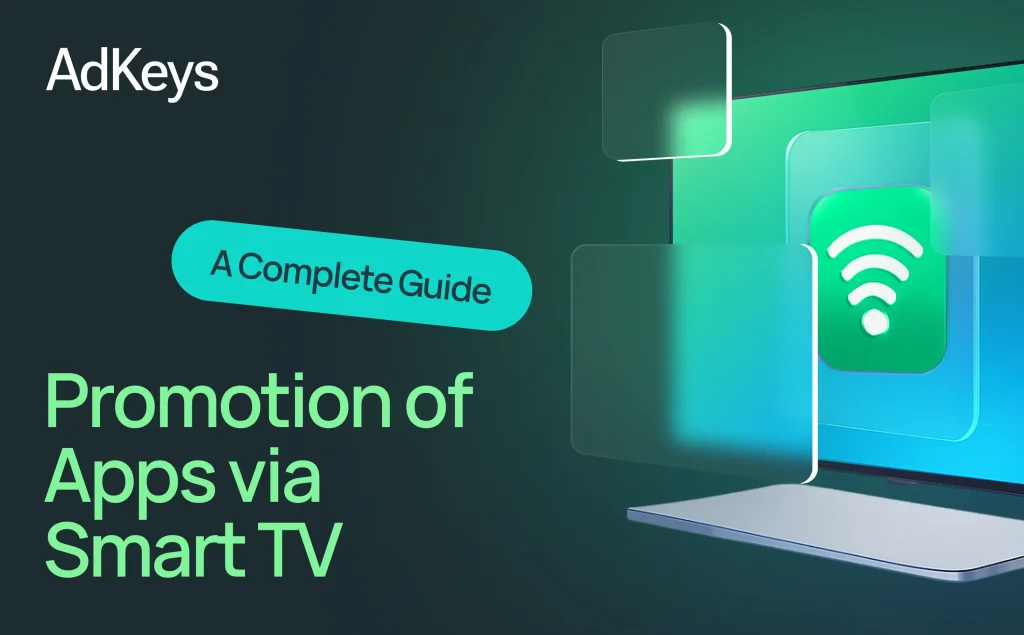
With the oversaturation of the mobile app market and fierce competition for user attention, the AdKeys team is constantly looking for new, effective channels for promotion. One of the promising and fast-growing areas is the promotion of apps via Connected TV (CTV). This channel offers unique opportunities to reach and interact with the audience on the big screen of a home theater.
What is Smart TV and Connected TV (CTV)?
Smart TVs are TVs that connect to the Internet and have built-in operating systems (e.g. webOS for LG, Tizen for Samsung, Android TV for Xiaomi) that allow you to install apps, stream video, use a browser and other online services.
Connected TV (CTV) is a broader term that encompasses any device connected to a TV that provides access to the Internet and streaming content. This includes not only Smart TVs, but also game consoles (PlayStation, Xbox), streaming devices (Apple TV, Amazon Fire TV, Google Chromecast, Roku), and set-top boxes from IP TV providers. Essentially, CTV is a way to deliver content over the internet to the big screen.
Besides, you can promote apps—right on the big screen, reaching a TV audience of many millions.
Moreover, CTV is no longer an alternative, as it was a few years ago, it is mainstream. According to Statista, in 2024, 92% of households in the U.S. will have at least one CTV device. Europe and Asia are also actively growing.
What's Good About Advertising on CTV? Advantages and Problems to Be Solved
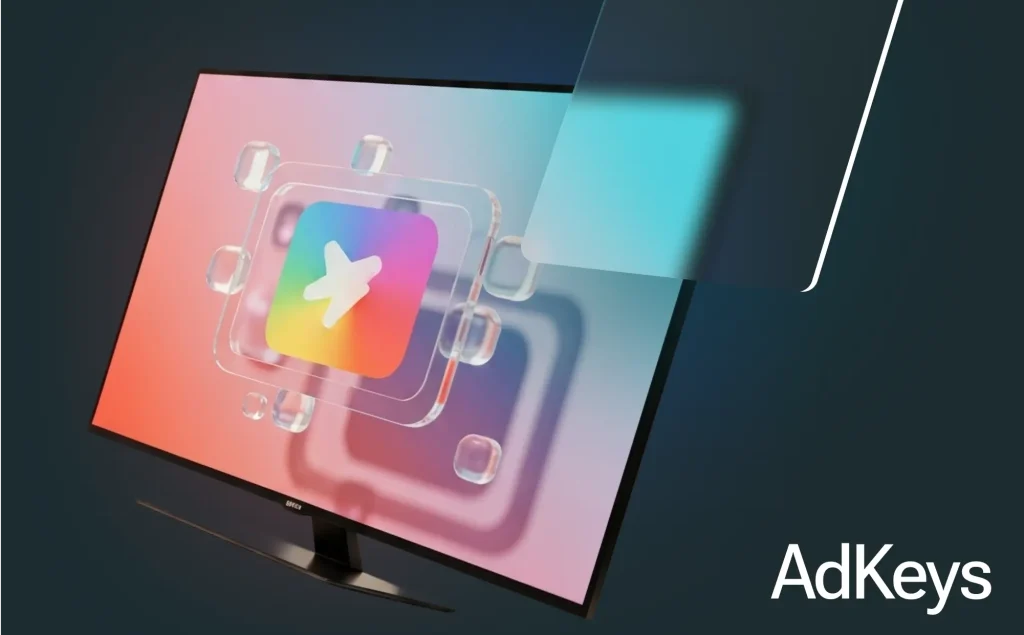
Advertising on CTV combines the benefits of television and digital advertising:
- Big Screen, Maximum Attention: unlike mobile devices where the user is constantly losing focus, viewing content on a large TV screen is often purposeful and accompanied by fewer distractions. This leads to higher levels of engagement and memorability of ads.
- Premium, family-oriented environment: CTV is a home-based, often family-oriented channel for content consumption. Ads shown in this environment are perceived as more authoritative and more trustworthy. According to the IAB, 57% of consumers find ads on CTV more engaging than on linear TV.
- The irresistible audience of “cord-cutters” (Cord-Cutters and Cord-Nevers): millions of people are abandoning traditional cable or satellite TV (cord-cutters) or have never used it at all (cord-nevers), switching entirely to streaming services. CTV is the only way to reach this solvent, tech-savvy audience.
- High click-through rates: many CTV ad formats are non-rewindable, and users are more accepting of short commercials and watch them to the end because it gives them access to the content they want. According to eMarketer, CTV video ad completion rates are as high as 95%.
- Precise targeting and measurability: unlike traditional TV, CTV offers digital-level targeting. As well as detailed analytics on impressions, views, clicks and even conversions.
- Programmatic + first party. Approximately 70% of CTV advertising is purchased through programmatic, and 60% of advertisers appreciate this for accurate targeting.
- Brand lift and performance: CTV significantly increases brand awareness and perception, which is especially important for new apps or those seeking to take a leading position in the market.
For Whom Do CTV Ads Work Better?
Advertising on CTV is especially effective for:
- Gaming apps: gamers are active users of Smart TVs and consoles, and promoting mobile games through this channel can be super effective.
- Streaming services and VOD platforms: natural synergy with the CTV ecosystem.
- Smart Home Apps: the Smart TV owning audience is often interested in other smart devices.
- eCommerce apps: opportunity to showcase products in an attractive format and drive purchases on mobile devices.
- Branded apps with high LTV: when it costs more to attract a user but the value is also higher, CTV can provide quality traffic.
- Fitness, meditation, education: something that is convenient to watch on a big screen.
- Any other apps: with the right approach, CTV provides support for user interest at all stages of the funnel and organic traffic growth due to recognizability.
Statistics and Trends
Where to Run Advertising on CTV: Sites and Their Peculiarities
The main players in the Smart TV market offering advertising opportunities are the manufacturers of the TVs themselves, who develop their own operating systems and app ecosystems.
1. LG TV
16.6% of the global TV market (but leader in OLED with 52% share and 3.18 million modules). In CTVsegment lg showed impressive EMEA growth of +42% (to ~17% share). Popular in Europe, US, Latin America. LG share among Smart TVs installed in households in Russia is about 25% (according to the analytical company J’son & Partners report “Smart TV Market in Russia. Results 2024” by the analytical company J’son & Partners).
Features: LG uses webOS operating system, known for its intuitive interface and smooth operation. LG is actively developing its own advertising platform LG Ad Solutions.
- Benefits:
- LG Ad Solutions: Gives advertisers access to extensive data on user behavior (with consent, of course), allowing them to build detailed segments for targeting. Offers a variety of formats, including native advertising and video ads.
- Global reach: LG is one of the largest TV manufacturers in the world, giving it a wide geographic reach.
- Advanced models (OLED Evo, transparent OLEDs) give marketers “premium inventory“.
- Differentiation: Emphasis on native placement in webOS interface and deep integration with content viewing data.
2. Samsung TV
28.3% of the global TV market, the leader for the last 19 years. It is most prevalent in the US, Europe and Russia. In CTV advertising the US has 12—13 % market share (YoY growth +51 % by Q4 2024).
Features: The TVs run on the Tizen operating system. Samsung Ads (formerly Samsung DSP) is one of the largest advertising platforms in CTV. Samsung TV Plus is the FAST services division with 450+ channels running ads across almost all TVs since 2016.
- Benefits:
- Huge Audience: With a leading market share, Samsung provides access to the largest Smart TV user base.
- Samsung Ads: Offers a wide range of targeting options, including demographics, interests, data on apps installed on the TV, and even shopping data (from anonymized data).
- Single platform: Samsung Ads allows you to manage campaigns on both your Smart TVs and connected devices.
- Unique data: Samsung collects unique data on user behavior on its devices, including linear TV viewing, app usage, and streaming services, allowing it to create very precise audiences.
- Differentiation: Leadership in audience size and richness of data for targeting. Active development of interactive advertising formats.
3. Xiaomi Mi TV
Top 1 in sales in CIS, China and India.
- Features: Their TVs run on Android TV, which gives access to Google’s vast ecosystem.
- Benefits:
- Android TV ecosystem: Integration with Google services including Google Play Store, YouTube, Google Assistant. This facilitates app distribution and discovery.
- Access to Google data: For advertisers who are already working with Google Ads, this can be an advantage as it allows them to use shared data for targeting.
- Growing Audience: Xiaomi is actively expanding its global footprint, which means an ever-growing audience.
- Flexibility: The Android TV platform is more open, which can provide more opportunities for customized advertising solutions.
- Targeting: by device, Mi ID, user behavior on other devices.
- Differences: Synergy with Google and Android ecosystem, making it attractive to developers already working with the platform.
Other Significant Platforms:
- Roku: Largest streaming platform in the U.S., offers extensive advertising opportunities. Lots of first-party data. Support for interactive formats.
- Amazon Fire TV: Another major player in the streaming device market, integrated with the Amazon ecosystem. Precise targeting based on purchase behavior.
- Apple TV: Despite smaller market share, provides premium audience and high quality advertising, but more limited inventory.
- Game consoles (PlayStation, Xbox): Offer advertising opportunities through their integrated stores and partner ad networks.
Advertising formats on CTV
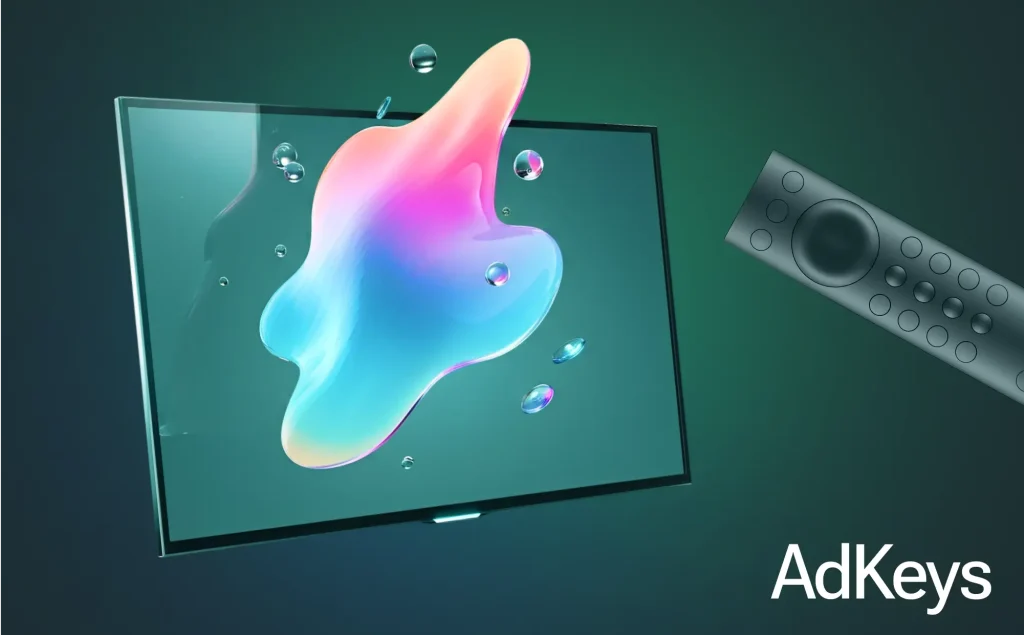
Advertising formats on CTV are constantly evolving. The main ones are:
- Video Ads (In-Stream Video Ads):
The most common format. Short videos (usually 15-30 seconds) that are shown before, during or after the main content (pre-roll, mid-roll, post-roll). According to Statista, video ads accounted for the lion’s share of all CTV ad spending in 2023.- Benefits: High viewability, premium placement, great for brand building.
- Example for apps: Gameplay demo of a game, short overview of app functionality, emotional video showing how the app solves a user’s problem.
- Native Ads:
Ads that fit seamlessly into the Smart TV interface, look like part of the system or content recommendations. These can be banners on the home screen, Pause ads, ad tiles in the “Recommended” or “Popular” sections. According to eMarketer, native advertising is becoming increasingly popular due to its unobtrusiveness and effectiveness.- Advantages: Less intrusive than video ads, perceived as a recommendation rather than a direct ad, which increases trust.
- Example for apps: A tile with an app icon and a short description on the Smart TV home screen or in the “New Apps” section.
- Interactive Ads / Clickable Ads:
Formats that allow the user to interact with the ad by remote control. These can be “Learn More” buttons, “Install App” buttons, QR codes to be scanned by a smartphone. Interactive formats show higher CTRs (Click-Through Rate) than non-interactive formats.- Benefits: Increases engagement, leads users instantly to the desired action (e.g., app download page), improves measurability of campaigns.
- App example: Video with a “Download Now” CTA button that, when clicked, opens a QR code for scanning or sends a link to a phone.
- Sponsored Apps:
Paid placement of an app in the top positions of Smart TV app stores or in special “Recommended” / “Popular” sections.- Benefits: Direct download path, high visibility among users actively searching for new apps.
- Example for apps: Your Mobile Fitness app appears first in the Health & Sports section of the LG Content Store.
- Branded Channels/Hubs:
Creating your own channel or hub on a Smart TV where users can access content related to your brand or app.- Benefits: Deep immersion of the user in the brand ecosystem, ability to provide valuable content and build loyalty.
- App example: A game developer creates a channel where users can watch trailers of their games, walkthroughs, interviews with developers, and links to game downloads.
Tracking and Analytics in CTV Advertising: How to Track That CTV Ads are Really Working?
Unlike mobile ads where you see installs, clicks, events, etc., it’s a little more complicated with CTV. But everything is solvable.
What can be tracked on CTV?
Impressions—how many times the ad was shown.
View-through installs (VTI)—how many users installed the app after viewing the advertisement (without clicking, but within a specified window).
Completion rate—how many people watched the video to the end.
Household reach—how many unique households were reached.
QR scans / CTA interactions—if a QR code is embedded in the video, transitions are tracked.
Cross-device events—if a person saw an ad on TV and later installed/opened an app on their phone.
What Tools and Trackers Should Be Used?
First consider tools like Weborama and Admon(Xiaomi MiTV) both trackers are important in the CTV ecosystem, especially because they are tightly integrated with specific TV vendors.
Weborama (LG Ads)
Weborama is a European adtech company specializing in semantic targeting and analytics. At CTV, they offer solutions for working with premium inventory.
What it can do:
Tracking impressions and views (viewability, completion rate)
Interest and content segmentation—based on semantic analysis of ACR data (what users actually watch)
Support for view-through attribution
Synchronization with mobile and desktop—you can track the impact of a CTV campaign on actions in other channels.
Real reach measurement—how many unique “households” saw the ads, how often, in what context
Pros:
✅ Deep integration with LG
✅ Excellent GDPR support and privacy-friendly approach
✅ Works well in European and Asian campaigns
✅ There is support for post-campaign analytics
Cons:
⚠️ Less flexibility compared to mobile-first MMPs (like Adjust, AppsFlyer)
⚠️ Limited access in some countries (through LG Ads partners)
Admon (Xiaomi MiTV)
Admon is an advertising and analytics platform created by Xiaomi itself, it is embedded in the MiTVecosystem (as well as in Mi Box, Mi Stick and other Android TV devices from Xiaomi). It’s used primarily in China, India, Southeast Asia, also in Russia, Latin America, and some Eastern European markets.
What it can do:
Tracking of shows and reach at the device level
Click-through tracking via remote (if user interacts)
Retargeting via Mi account—e.g. saw an ad on TV → got a push to smartphone
Deep integration with Xiaomi Ads DSP
Pros:
✅ Precise connectivity with Xiaomi mobile devices
✅ Good reach in India and SEA
✅ First-party Xiaomi data
Cons:
⚠️ Limited analytics outside of the Xiaomi ecosystem
⚠️ API and reporting may be less flexible (especially outside of China)
⚠️ The platform is hardly used in Western countries
List of Other Popular Solutions That Support CTV
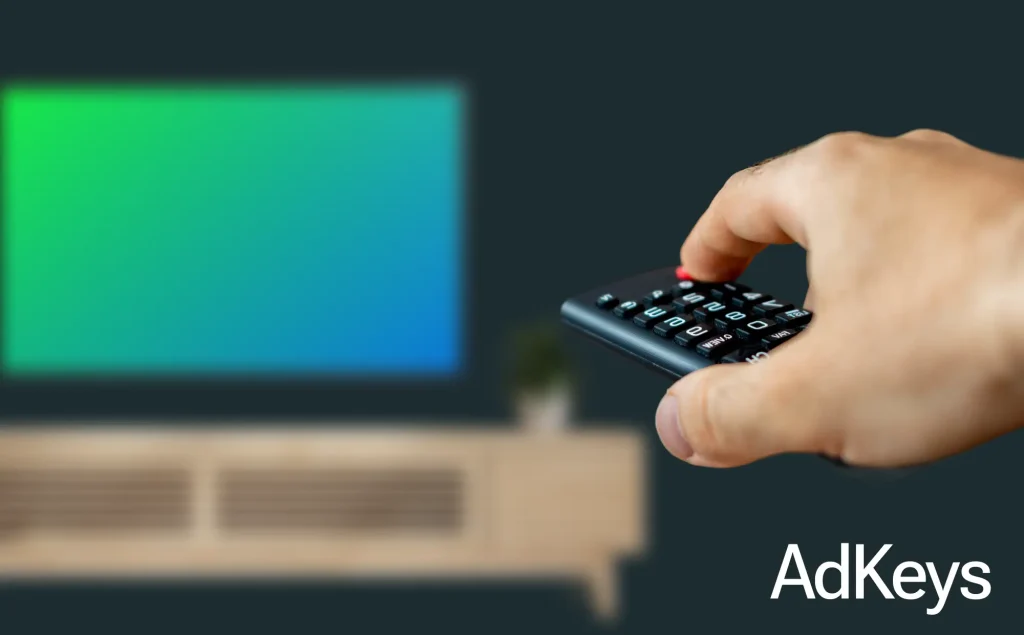
Adjust:
- Supports view-through attribution on CTV.
- You can connect QR codes with parameters.
- Allows you to analyze the impact of ads on mobile installs.
AppsFlyer:
- View-through and click-through attribution.
- Special CTV attribution toolkit—tracks installations, app events and retargeting.
- Supports household-level tracking.
Branch:
- Deep links, QR codes, CTV-to-mobile transitions.
- You can build a link “seen on TV → clicked → opened app store → installed”.
Kochava:
- One of the strongest multi-device attribution platforms.
- Allows you to combine data from CTV, mobile, desktop.
- Integrations with Roku, Samsung Ads, LG Ads, etc.
Другие полезные инструменты:
QR Code generators with UTM and deeplinksupport—e.g. Bitly, Short.io.
DSPs and SSPs with analytics: The Trade Desk, Google DV360, Samsung Ads, LG Ads—they also have built-in statistics on impressions and reach.
Where to Run: List of DSPs and SSPs That Support CTV
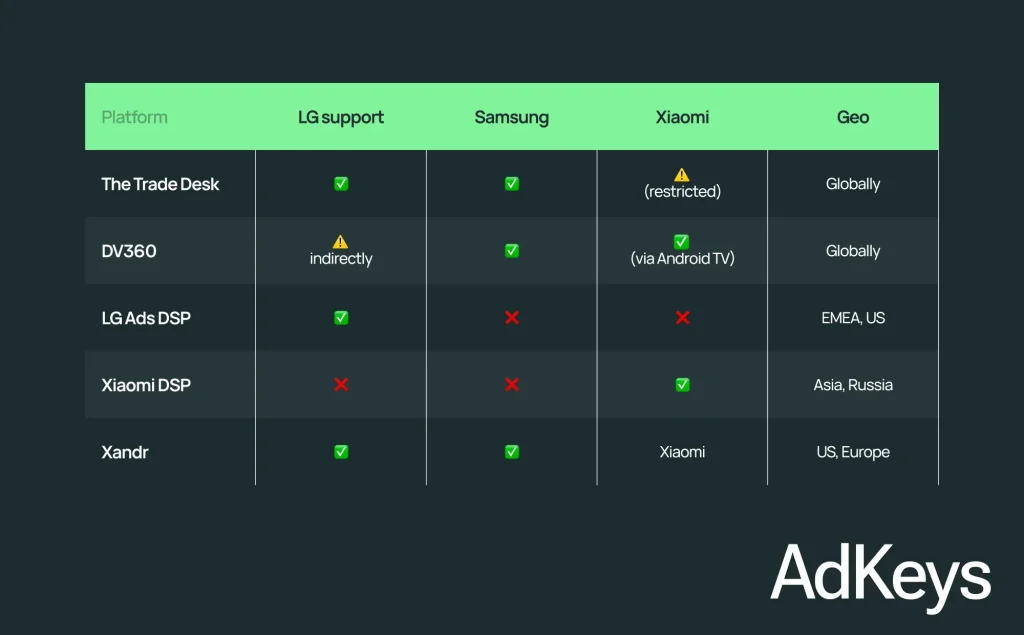
Tips:
Don’t ignore view-through—CTV rarely gets clicked, but the effect often shows up later.
Test different attribution windows: 1 hour, 6 hours, 24 hours—see where the response is better.
Combine: using CTV + retargeting in mobile ads? Look at the linked uplift.
Use A/B: the same creatives—one campaign with QR, the other without. Compare installs.
Development Projections and Recommendations
The CTV advertising market is in a phase of rapid growth and this trend will continue in the coming years.
Significant growth in investment is expected. According to eMarketer, global CTV ad spending is expected to reach $46 billion by 2026.
There will be an increasing share of interactive advertising, as it provides a better response and allows for better tracking of conversions. As well as the development of new formats—voice, AR-formats.
Data collection, targeting and attribution technologies will improve, allowing marketers to more accurately target audiences and measure ROI.
Synergies between CTV advertising and mobile devices are expected to be further developed, for example, through the use of QR codes, second screen technology and cross-device targeting.
Recommendations for Promoting Apps Through CTV:
- Define your target audience and platform: not all devices cover the segment you want to reach equally.
- Start with video: create CTV-oriented creative—high-quality videos optimized for a large screen, large text, clear call-to-action, short timing. Don’t forget to work on audio accompaniment, as most videos are viewed with sound.
- Use interactive elements: Include QR codes, Call-to-Action (CTA) buttons or links that make it easy for the user to go from a large screen to a mobile device to download the app.
- Test and Optimize: As with any digital campaign, continually test different creatives, formats, targeting and measure results to optimize.
- Consider native advertising: Integration with a Smart TV interface can be very effective in building awareness and trust.
- Integrate CTV into the overall marketing funnel: Especially in the upper stages (awareness).
- Think cross-platform: Take into account that users can see your TV ad and then search for the app on their smartphone. Ensure a seamless transition.
- Use cross-device tracking: Track how CTV interactions affect mobile installs.
- Collaborate with experts: The CTV market is complex and changing rapidly. Working with ad agencies that specialize in CTV can dramatically improve the performance of your campaigns.
We don’t just talk about CTV opportunities, we implement them. Our agency already has successful experience in this field. Check out AdKeys’ case studies on promoting apps on Smart TVs, where we share specific results and strategies that helped our clients achieve great results on LG TV and Xiaomi Mi TV platforms.
Smart TV is not just "another channel", it's a game-changer. We're talking about your audience sitting relaxed at home, watching the big screen while being fully engaged. This isn't some fidgety minute on the subway with your phone! Investing in CTV now is not just about following trends, it's about taking a leadership position in one of the fastest growing and most promising segments of digital marketing.
Yana Brazinskaya, Digital Marketing Manager
